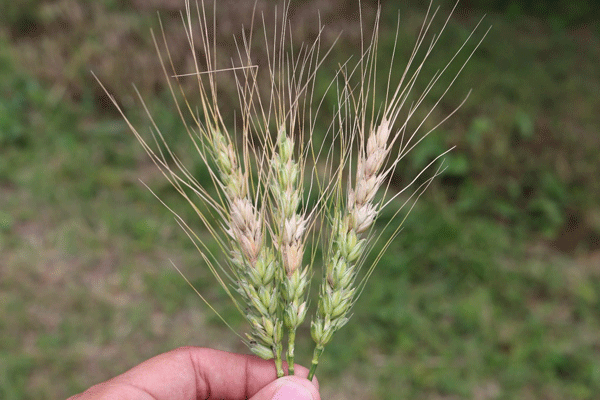A family tussle between related species of fungi is underway in the soils of the world’s cereal fields, for control of the crops’ roots, with food security threatened if the wrong side wins. Beneficial fungi can help plants to protect themselves from cousins eager to overwhelm the roots, but it is a closely fought battle.
Working out the right conditions to support those beneficial fungi and identifying the cereal varieties that are best suited to make the most of that help is no mean task, but now a young team of scientists from Rothamsted Research has come up with some answers. Their complete findings were published in the Journal of Experimental Biology.
Take-all is a devastating root disease of cereal crops worldwide caused by the fungal pathogen Gaeumannomyces tritici. Related species, notably G hyphopodioides, are capable of immunising plant roots against the pathogen. Farmers struggle to control the disease because few chemical seed treatments are available and current biological strategies are hindered by the variety of soil types.
Gaeumannomyces graminis is pathogenic on many members of the Poaceae family but is most commonly a problem on wheat. G graminis var tritici is the form of the fungus that attacks wheat and related species.
Vanessa McMillan, the co-author and postdoctoral researcher in plant pathology said that his work “aimed to explore whether wheat genetics can be exploited to help support and potentially build up populations of closely related take-all suppressing fungal species that are known to lower the disease levels caused by the take-all fungus.”
During the research, the team of researchers collected samples of the beneficial fungus from the fields of Rothamsted Farm and developed a laboratory test to explore its ability to colonise and protect the roots of barley, rye, wheat, and the rye/wheat hybrid, triticale. In field trials, the team identified commercial cereal varieties that performed better than others.
McMillan, who led the take-all research group at Rothamsted, noted, “if the ability of wheat cultivars to support and be colonised by natural or introduced populations of beneficial Gaeumannomyces species could be harnessed and exploited, either through a seed dressing or via direct application into a crop’s rooting zone, this could provide a potential biological management strategy for the control of take-all disease in wheat crops.”
According to the study, understanding the complex interactions between the fungi and the cereal hosts will yield more information for developing strategies to control the disease.
“The future of take-all control cannot rely upon a single solution to combat the disease,” said Sarah-Jane Osborne, whose PhD in crop pathology focused on this research. “The results of our study show that certain current winter wheat varieties can strongly support naturally occurring populations of take-all suppressing fungi,” she added.
Osborne, who is now field trials manager for crop production systems at the Agriculture and Horticulture Development Board (AHDB), added, “if this ability can be harnessed, it could aid in decision-making when selecting varieties to grow as an additional practical solution to manage take-all disease.”
“Our ability to manage take-all is currently limited and having an effective genetic solution would be very beneficial to growers,” said David Langton, Head of research and development and stewardship at Agrii, a company of agronomists. He added, “therefore, Agrii was pleased to support Sarah-Jane’s PhD to develop a better understanding of the disease and potential management options.”




